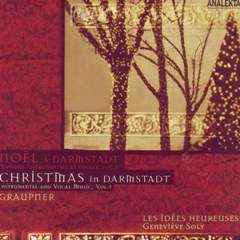Graupner - Christmas in Darmstadt (2007)
Graupner - Christmas in Darmstadt (2007)

Cantata for Whitsunday 1. Choral : Wie Schön Leuchtet Der Morgenstern 3:16 Cantata For The First Sunday Of Advent 2. Concerto (Ténor Et Alto) 1:15 3. Aria: Affettuoso (Alto) 7:33 4. Choral: Vivace (Mélodie: Nun Komm Der Heiden Heilang) 0:53 5. Aria (Soprano, Basse) 5:17 6. Récitatif (Ténor) 1:01 7. Choral 0:53 Overture in F Major For Recorder and Strings 8. Ouverture - Allegro 5:20 9. La Speranza (Tempo Giusto) 2:53 10. Air(S) En Gavotte (I, II, III) 3:23 11. Menuet (I, II) 2:40 12. Air(S) (I, II) 5:11 13. Plaisanterie(S) (I, II, III) 4:02 Cantata For The First Sunday After Christmas 14. Dictum (Ténor) 0:41 15. Récitatif (Alto) 1:07 16. Aria (Alto) 2:43 17. Récitatif (Ténor) 1:00 18. Choral 0:55 19. Aria (Ténor) 2:44 20. Récitatif (Ténor) 1:01 21. Choral 0:58 Canata For Solo Bass, For The Third Day Of Christmas 22. Choral 1:33 23. Récitatif 1:27 24. Aria : Vivace 5:19 25. Dictum 1:20 26. Récitatif 1:15 27. Aria : Allegro 4:33 Les Idées Heureuses Geneviève Soly - director
Bach contemporary Christoph Graupner was a significant figure in 18th-century Lutheran church music, writing with a seemingly tireless facility for the cantata in its various configurations (he wrote more than 1400!). This program, another in Geneviève Soly and Analekta’s fine Graupner Project series, and its accompanying liner notes aim to provide a context “in order to better understand” this composer’s music, in this case the Christmas cantatas. So we’re given not only historical background regarding Darmstadt in the first half of the 18th century, but also a short, simple description of the Lutheran cantata, its structure, and the significance of its different sections. The choice of works is designed to show how Graupner handled both the organization of the textual material for three different services–First Sunday of Advent, Third Day of Christmas, and First Sunday after Christmas–and how he used a variety of performing forces to convey the meaning of the texts and the appropriate sense of occasion. Interestingly, we hear instances of Graupner’s adeptness for “word painting” and, as Bach so masterfully did, his ability to incorporate familiar chorale melodies into the larger musical fabric.
Anyone who may be expecting to find in Graupner a sort of unsung master worthy of Bachian pretensions won’t find what they’re looking for. Instead, they’ll discover a composer who was very comfortable with the idioms of his day, who knew how to write melodically interesting material, and, most importantly, understood perfectly the practical demands of his work, which (among other duties) was to provide new cantatas for Sundays and feast days, month after month, year after year. On evidence so far, he was able to perform this task with impressively varied use of soloists, orchestra, and chorus–and with the help of his able librettist Johann Lichtenberg. He created engaging arias–the extended alto piece in the Advent cantata “Machet die Tore weit”, for instance–and colorful instrumental accompaniments whose rhythmic/melodic/harmonic figures often add their own commentary on the text.
No, in Graupner we don’t find the profound import inherent in Bach’s every chorus, orchestral overture, or aria (contemporaries Zelenka and Heinichen come much closer), but we can easily appreciate his very functional, reverential style, the clear, uncluttered orchestration, and the direct and very appealing if comparatively unremarkable recitatives and arias. The orchestra here is a fine baroque ensemble and it plays capably with spirit and precision and with requisite care for stylistic mannerisms. The solo singers range from adequate (soprano and bass) to above average (the alto and tenor), but even so, there’s inconsistency among the soloists that both elevates some performances and diminishes the impact of others. Although the charming Overture for recorder and strings wasn’t part of Christmas festivities at Darmstadt, Soly includes it here for aesthetic reasons–because of the recorder’s long association with Christmas–and Natalie Michaud’s brilliant performance makes an excellent foil for the vocal works. First-rate sound complements and enhances everyone’s effort, and thanks to these committed musicians–and to Graupner’s vast and largely still-unexplored output–baroque vocal music fans have yet another CD justly begging for their attention. ---David Vernier, classicstoday.com
download (mp3 @320 kbs):
Last Updated (Tuesday, 25 December 2018 11:06)








